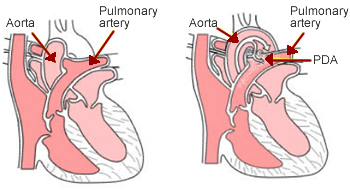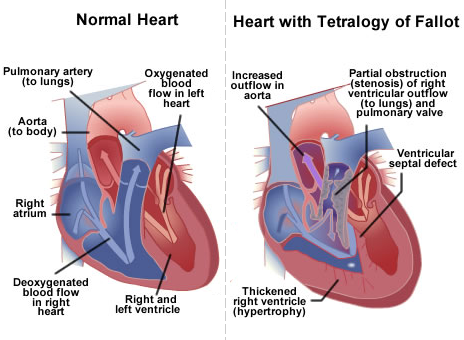Congenital Heart Disease (CHD)
- Classification
- ASD & VSD
- Persistent ductus arteriosus (PDA)
- Truncus arteriosus
- Tetralogy of Fallot
- Transportation of the great vessels
Classification
In general CHD is classified as cyanotic and noncyanotic:
Click on each title to see a description.
- Tetralogy of Fallot
- Transposition of the great vessels
- Total anomalous pulmonary venous return
- Truncus arteriosus
- Tricuspid atresia
- Ebstein's anomaly
- Hypoplastic left heart or right heart
- Patent ductus arteriosus (PDA)
- Ventricular septal defect (VSD)
- Atrial septal defect (ASD)
- Aortic stenosis
- Pulmonic stenosis
- Coarctation of the aorta
- Endocardial cushion defect (Atrioventricular canal)
Congenial heart disease (CHD) affects 8/1000 newborn infants. It usually presents in the first year of life and ranges from simple to complex structural abnormalities.
One important difference between CHD and acquired heart disease is the presence of shunts although not all congenital malformations of the heart involve shunts.
CHD could be associated with one or multiple abnormalities or pathologies involving:
a) Development of the heart
b) Heart valves
c) Position or development of blood vesselsnear the heart
d) Abnormal blood flow or passages in the heart or between blood vessels
Congenital heart disease is treated with drugs and/or surgery. In the recent times, the outlook for children with CHD has improved markedly. Many types of CHD that would have been fatal now can be treated successfully.

PDA is the persistence of a normal fetal structure between the left pulmonary artery and the descending aorta. At birth, the ductus normally undergoes closure. Persistence of this fetal structure beyond 10 days of life is considered abnormal. In general, in small PDA, no symptoms are present. In patients with PDA with a moderate-to-large left-to-right shunt may clinically present with a hoarse cry, cough, lower respiratory tract infections (LRTI), atelectasis, or pneumonia etc. When the defect is large, congestive heart failure (CHF) with dyspnoea and poor weight gain or failure to thrive are the main clinical presentations.

Truncus arteriosus is a congenital complex malformation where only one artery arises from the heart and forms the aorta and pulmonary artery. It is characterised by a large ventricular septal defect over which a large single great vessel arises.
The most common signs and symptoms are:
- Cyanosis
- Lack of appetite
- Poor weight gain
- Difficulty breathing
The main characteristics of Tetralogy of Fallot are:
- Pulmonary stenosis
- Ventricular septal defect (VSD)
- Overriding aorta
- Right ventricular hypertrophy (RVH)
The most common signs and symptoms are:
- Cyanosis
- Shortness of breath
- Fainting episodes
- Clubbing of fingers and toes
- Lack of appetite
- Poor weight gain
- Irritability
- Easy fatigability

A normal heart and one showing transposition of the great vessles
Transposition is a condition in which the aorta arises from the right ventricle and the pulmonary trunk from the left. The most common signs and symptoms are:
- Cyanosis
- Shortness of breath
- Cubbing
- Poor feeding


